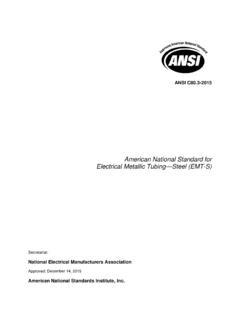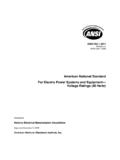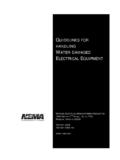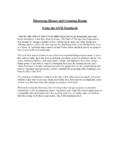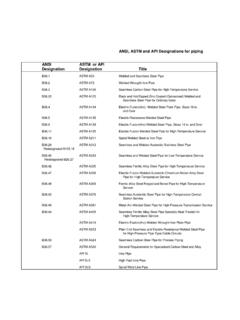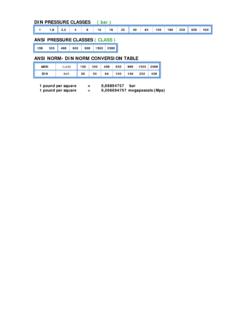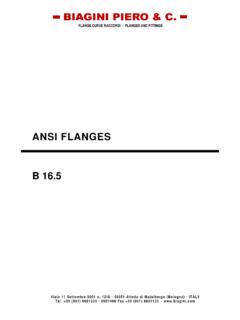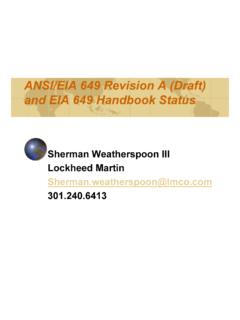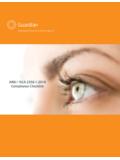Transcription of NEMA Pub of ANSI adopt of IEC stds disclaimer
1 ansi Approval Date November 3, 2004 ansi /IEC 60529-2004 Degrees of Protection Provided by Enclosures (IP Code) (identical national adoption) Published by: National Electrical Manufacturers Association 1300 North 17th Street, Suite 1847 Rosslyn, Virginia 22209 Copyright 2004 by the National Electrical Manufacturers Association. All rights including translation into other languages, reserved under the Universal Copyright Convention, the Berne Convention for the Protection of Literary and Artistic Works, and the International and Pan American Copyright Conventions. AMERICAN NATIONAL STANDARD Approval of an American National Standard requires verification by ansi that the requirements for due process, consensus, and other criteria for approval have been met by the standards developer.
2 Consensus is established when, in the judgment of the ansi Board of Standards Review, substantial agreement has been reached by directly and materially affected interests. Substantial agreement means much more than a simple majority, but not necessarily unanimity. Consensus requires that all views and objections be considered, and that a concerted effort be made toward their resolution. The use of American National Standards is completely voluntary; their existence does not in any respect preclude anyone, whether he has approved the standards or not, from manufacturing, marketing, purchasing, or using products, processes, or procedures not conforming to the standards. The American National Standards Institute does not develop standards and will in no circumstances give an interpretation of any American National Standard.
3 Moreover, no person shall have the right or authority to issue an interpretation of an American National Standard in the name of the American National Standards Institute. Requests for interpretations should be addressed to the secretariat or sponsor whose name appears on the title page of this standard. Caution Notice: This American National Standard may be revised or withdrawn at any time. The procedures of the American National Standards Institute require that action be taken periodically to reaffirm, revise, or withdraw this standard. Purchasers of American National Standards may receive current information on all standards by calling or writing the American National Standards Institute, 11 West 42nd Street, New York, NY, 10036, phone (212) 642-4900.
4 Published by National Electrical Manufacturers Association 1300 North 17th Street, Rosslyn, VA 22209 Copyright 2004 by the National Electrical Manufacturers Association. All rights including translation into other languages, reserved under the Universal Copyright Convention, the Berne Convention or the Protection of Literary and Artistic Works, and the International and Pan American Copyright Conventions. No part of this publication may be reproduced in any form, in an electronic retrieval system or otherwise, without the prior written permission of the publisher. Printed in the United States of America NOTICE AND disclaimer ( ansi Adoption of IEC Standards) The information in this publication was considered technically sound by the consensus of persons engaged in the development and approval of the document at the time it was developed.
5 Consensus does not necessarily mean that there is unanimous agreement among every person participating in the development of this document. American National Standards, of which the document contained herein is one, are developed through a voluntary consensus standards development process. This process brings together volunteers and/or seeks out the views of persons who have an interest in the topic covered by this publication. This publication was reviewed and approved under the procedures of the American National Standards Institute whereby a standard developed by a technical committee of the International Electrotechnical Commission (IEC) was adopted as an American National Standard.
6 NEMA administered the process in accordance with the procedures of the American National Standards Institute to promote fairness in the development of consensus. As a publisher of this document, NEMA does not write the document and it does not independently test, evaluate or verify the accuracy or completeness of any information or the soundness of any judgments contained in its standards and guideline publications. NEMA disclaims liability for any personal injury, property or other damages of any nature whatsoever, whether special, indirect, consequential or compensatory, directly or indirectly resulting from the publication, use of, application, or reliance on this document.
7 NEMA disclaims and makes no guaranty or warranty, express or implied, as to the accuracy or completeness of any information published herein, and disclaims and makes no warranty that the information in this document will fulfill any of your particular purposes or needs. NEMA does not undertake to guarantee the performance of any individual manufacturer s or seller s products or services by virtue of this standard or guide. In publishing and making this document available, NEMA is not undertaking to render professional or other services for or on behalf of any person or entity. Nor is NEMA undertaking to perform any duty owed by any person or entity to someone else.
8 Anyone using this document should rely on his or her own independent judgment or, as appropriate, seek the advice of a competent professional in determining the exercise of reasonable care in any given circumstances. Information and other standards on the topic covered by this publication may be available from other sources, which the user may wish to consult for additional views or information not covered by this publication. NEMA has no power, nor does it undertake to police or enforce compliance with the contents of this document. NEMA does not certify, test or inspect products, designs or installations for safety or health purposes.
9 Any certification or other statement of compliance with any health or safety related information in this document shall not be attributable to NEMA and is solely the responsibility of the certifier or maker of the statement. INTRODUCTION This standard describes a system for classifying the degrees of protection provided by enclosures of electrical equipment for two conditions: 1) the protection of persons against access to hazardous parts and protection of equipment against the ingress of solid foreign objects and 2) the ingress of water. The degree of protection against these two conditions is designated by an IP Code. Enclosures as used in this standard are as defined in the standard.
10 This includes not only traditional metallic or polymeric enclosures but any enclosing part of electrical equipment that provides a degree of protection as defined in the scope. As such the use of this system allows specific ratings to be applied to different parts of the equipment. For example a component with an IP20 rating indicating only a degree of protection against contact with live parts within that component could be used within an overall enclosure with an IP43 rating that provides a degree of protection against probes and solid foreign objects as well as splashing water. While the IP Code system is suitable for most types of electrical equipment, it must be noted that this standard is a horizontal standard and not a product standard.


